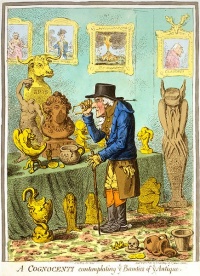Antique
From The Art and Popular Culture Encyclopedia

|
Related e |
|
Featured: |
An antique (from Latin antiquus; old) is an old collectable item. It is collected or desirable because of its age (see definition), beauty, rarity, condition, utility, personal emotional connection, and/or other unique features. It is an object that represents a previous era or time period in human society. It is common practice to define "antique", as applying to objects at least 100 years old. Collectibles are, generally speaking, the possible antiques of the future and generally less than 100 years old.
The only real law concerning the definition of the word antique comes from the US customs office, that considers antique as anything 100 years old.
Antiques are usually objects which show some degree of craftsmanship, or a certain attention to design such as a desk or an early automobile. They are most often bought at antique shops, or passed down as an estate. Some valuable antiques can be bought from antique dealers and auction services or purchased online through websites and online auctions. Antique dealers are often members of national trade associations, many of which belong to CINOA, a confederation of art and antique associations across 21 countries, representing 5000 dealers.
Contents |
Purpose
In history
Any historical museum makes a considerable use of antiques in order to illustrate historical events and give them a practical context. Just about any object can become an antique if it survives long enough, but value of an antique in the market place is determined by its appeal and social acceptance. For example museums exist of Ephemera, that is of objects and items that would normally be thrown away, such as packaging and advertising flyers and posters.
As heirloom
The term "antique" is pejorative in some instances to describe something passed down from generation to generation.
Definition
The definition of antique varies from source to source, product to product, and year to year.
The only known exception to the "100 year rule" would be cars. Since the definition of the term antique requires an item to be at least 100 years, or older, and the item in question must be in its original and unaltered condition, most cars clearly would not meet these terms, as yet. So, cars have generally been considered to be 'antique' if they are roughly 75 years old, or more (some cars can be registered as "classic" when 25 years old, such as muscle cars and luxury vehicles such as Rolls-Royce and Bentley). Furthermore, this is not a universally accepted concern, but rather a consideration made almost strictly by car collectors and enthusiasts.
In the United States, the 1930 Smoot-Hawley Tariff Act defined an antique as "works of art (except rugs and carpets made after the year 1700), collections in illustration of the progress of the arts, works in bronze, marble, terra cotta, parian, pottery or porcelain, artistic antiquities and objects of ornamental character or educational value which shall have been produced prior to the year 1830." 1830 was roughly the beginning of mass production in the US and 100 years older than 1930 Smoot-Hawley Tariff Act.
These definitions allow people to make a distinction between genuine antique pieces, vintage items, and collectible objects.
The alternative term antiquities commonly refers to the remains of ancient art and everyday items from antiquity, which themselves are often archaeological artifacts.
The term antiquarian refers to a person interested in antiquities, or things of the past.
Antiquing
"Antiquing" is the act of shopping, identifying, negotiating, or bargaining for antiques. Items can be bought for personal use, gifts, and in the case of brokers and dealers, profit. Antiquing is performed at garage sales, estate sales, resort towns, antiques districts, collectives, and international auction houses.
Note that the word "antiquing" may also refer to the art of making an object appear antique through distressing or applying an antique looking paint application.
Antique furniture
The collecting of antique furniture is a particularly popular area of antiques due to the practical characteristics of these antiques. Antique furniture includes dining tables, chairs, bureaus, chests etc. The most common woods are mahogany, oak, pine, walnut and rosewood. In Chinese antique furniture the most common wood is elm a wood common to most regions able to sustain trees. Each wood has its own distinctive grain and colour. Many modern pieces of furniture often use laminate or wood veneer to cheaply achieve the same effect. There are a number of different styles of antique furniture depending on when and where it was made. The most common include Arts & Crafts, Georgian, Regency and Victorian.
See also
- Antique Books
- Antique furniture
- Antique shop
- Antique tools
- Antiques restoration
- Antiquities
- Auctions
- Authenticity
- Car donation
- CINOA- principal international art & antique dealer federation
- Collectables
- Collective
- Estate sale
- Jackson Square, San Francisco, California
- Marketing
- Original
- The San Francisco Fall Antiques Show
- Treasures.tv
- Vetting
- Vintage

